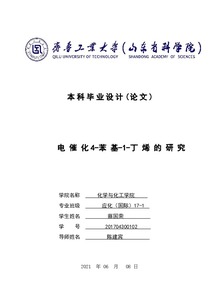Study on electrocatalysis of 4-phenyl-1-butene
Guorong, Cai (2021)
Guorong, Cai
2021
All rights reserved. This publication is copyrighted. You may download, display and print it for Your own personal use. Commercial use is prohibited.
Julkaisun pysyvä osoite on
https://urn.fi/URN:NBN:fi:amk-2021070616755
https://urn.fi/URN:NBN:fi:amk-2021070616755
Tiivistelmä
In recent years, the electrochemistry has been greatly developed. In particular, electrocatalytic strategies have been used to achieve C−C,C−O,C−N and C−S bond formation reactions. As is known to all, oxyhalogenation unsaturated hydrocarbon with halide ions has also been reported. So we would like to try nitrogen halogenation unsaturated hydrocarbon with halide ions. Traditional compositing conditions are usually limited, these include excessive use of strong oxidants, these kinds of reagents were often required in stoichiometric quantity and some of them were expensive and toxic, higher reaction temperature and lower atom efficiency.
The development of electrochemical organic synthesis is a testimony to the gentleness and sustainability of electrochemistry. Compared with traditional reactions, electrochemical solutions do not require the use of toxic or other dangerous oxidants. The revival of electrochemical organic synthesis technology is of great significance and demonstrates the gentleness and sustainability of electrochemistry. Compared with traditional oxidation reactions, electrochemical protocols do not require the use of toxic or dangerous oxidants.
In general, LiCIO4 as electrolyte, DMF as solvent, Chlorine source from MgCI2.6H2O, CeCI3 as catalyst, RVC(+)RVC(-) as electrodes in this laboratory work. The advantage of electrochemistry is environmental protection, easy to handle, low consumption and non-toxic.
The development of electrochemical organic synthesis is a testimony to the gentleness and sustainability of electrochemistry. Compared with traditional reactions, electrochemical solutions do not require the use of toxic or other dangerous oxidants. The revival of electrochemical organic synthesis technology is of great significance and demonstrates the gentleness and sustainability of electrochemistry. Compared with traditional oxidation reactions, electrochemical protocols do not require the use of toxic or dangerous oxidants.
In general, LiCIO4 as electrolyte, DMF as solvent, Chlorine source from MgCI2.6H2O, CeCI3 as catalyst, RVC(+)RVC(-) as electrodes in this laboratory work. The advantage of electrochemistry is environmental protection, easy to handle, low consumption and non-toxic.
